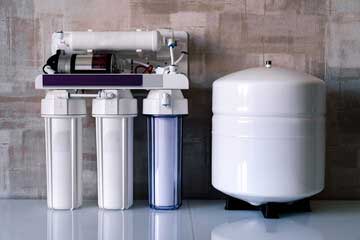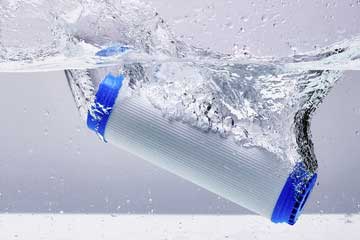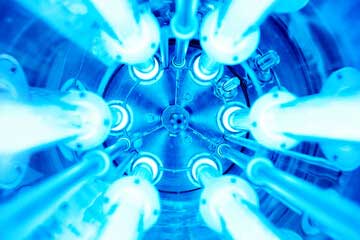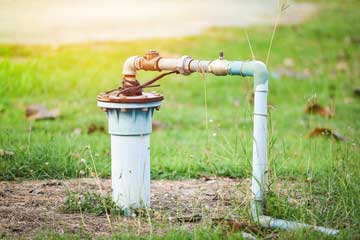 Water in nature is never really perfect and comes to us with impurities from living organisms, suspended substances, and dissolved gases and solids. All of these can affect the taste and appearance of water, not to mention its degree of both safety and hardness. The reverse osmosis process is the same process that many hospitals throughout the country have used to make certain that their pharmaceutical water is of the highest quality.
Water in nature is never really perfect and comes to us with impurities from living organisms, suspended substances, and dissolved gases and solids. All of these can affect the taste and appearance of water, not to mention its degree of both safety and hardness. The reverse osmosis process is the same process that many hospitals throughout the country have used to make certain that their pharmaceutical water is of the highest quality.
Your drinking water comes from two main sources: ground waters (wells and springs), and surface water (lakes, streams, rivers, and ponds). Both sources are replenished by rain, which dissolves and carries contaminants into surface and underground aquifiers. Some of these contaminants are dioxin, THM's, arsenic, and other chemicals, which can be dangerous even when measured in the parts per billion range.
Over 6 million Canadians need to restrict their intake of salt (NaCl) because of high blood pressure, yet almost every water supply has sodium chloride in it. Nitrates and phosphates from fertilizers enter our water supplies as run-off during rainstorms and irrigation. Nitrates over 10 parts per million may cause intestinal and stomach cancer.
A home reverse osmosis (R.O.) system can substantially reduce dissolved minerals such as calcium, magnesium, sodium, arsenic, uranium, lead, aluminum and manganese as well as brackish mineral salts, chlorides, and other tastes. The result is cleaner, healthier drinking water.
Water contains total dissolved solids (TDS), which is the measurement by weight of dissolved materials in a given volume of water. If a material will completely dissolve and is not visible in the water, it is part of the total dissolved solids. Reverse Osmosis helps to lower the TDS content of water (such as brackish water, saline water, or seawater) since substances such as calcium, magnesium, and sodium cannot readily pass through the semi-permeable membrane, while water can. With the assistance of water pressure, impurities are removed and sent down the drain.
R.O. is a membrane process that acts as a molecular filter to remove up to 99% of all dissolved minerals. The pores in the membrane are about .0006 microns in size. To give you some perspective, the smallest known bacteria is .02 micros. Water passes through the membrane while the dissolved solids and particulate materials are left behind. As pressure is applied to the concentrated solution, the flow is reversed and water is forced through the membrane from the concentrated side to the dilute side.
Water molecules penetrate the thin layer of the reverse osmosis membrane and diffuse through it molecule by molecule. Dissolved salt ions would also diffuse through this layer, except that the solubility of the salt ions in the membrane is much less than that of the water. Thus, the water moves through more rapidly with the result that a separation occurs. The driving force is furnished by both the pressure and the concentration differentials across the thin layer. For water, the pressure effect is the most important. Therefore, increases in pressure increase the water flux without a corresponding increase in salt flux.
This process removes most of the dissolved mineral salts, almost all of the particulate matter, and most of the dissolved organic compounds. With reverse osmosis systems, water pressure must be maintained at 40-70 pounds per square inch (PSI) to keep a driving force across the membrane to produce a high clarity, low mineral content water. Most reverse osmosis systems operate in the 25-50% conversion range. This means that at 50% conversion, 100 gallons of feed water will produce 50 gallons of pure water (permeate)and 50 gallons of brine (concentrate).
Other methods of water treatment such as water softening and anti-scalant injection, are also important and it is a combination of these along with reverse osmosis that will normally produce the highest quality water. It should be noted that a reverse osmosis system is not a solution for all water problems and that water must be potable - safe for human consumption - before it is put through an reverse osmosis system.
The central part of the reverse osmosis system is the module which is a pressurized container housing the semi-permeable membrane. Cellulose Triacetate (CTA) membranes are used for chlorinated supplies. Thin Film Composite (TFC) long life membranes are used for non-chlorinated water supplies. Here the feed water will be separated into usable product called permeate and waste product called concentrate. On either side of the module may be two carbon filters, one which pre-treats the feed water, the other which post-treats the permeate.
The product water may then pass into a diaphragm pressure tank, which holds the water until it is taken from the discharge faucet by the user. Countertop units, however normally omit a pressurized storage tank and discharge directly into a non-pressurized container. Most of these systems have a one to five gallon capacity, usually more than adequate for drinking and cooking purposes. Unlike the larger commercial systems, a pump is not required to provide additional pressure. The home R.O. system operates on line or system pressure. No electricity is needed. Its compactness allows the system to fit easily in a small area, often under the kitchen sink or in a cabinet.
The home low pressure R.O. system is designed for use on a potable drinking water supply. In addition, the water should be clear in appearance, not turbid or cloudy, and without offensive taste. If these conditions have not been met, the water will require treatment before putting it through the R.O. system. Good quality feed-water is essential if the system is to function properly and produce a satisfactory product. This is why the carbon filter system is important: it can treat the feed-water for chlorine removal, as well as reduce suspended solids.
Reasonable care must be taken to prevent damage to the R.O. membrane. Factors which can shorten the life of the membrane include scaling, excessive pressure or temperature and bacteria and chlorine degradation. By exercising care, avoiding extremes in feed-water impurities, and occasionally cleaning and monitoring the system, these problems may be prevented. However, periodically changing the membrane will be necessary.
A sample of water is a must when sizing the R.O. system. The main water tests that must be considered are:
- iron content of water - both clear and colored
- total hardness content of the water
- total dissolved solids level in ppm
- chlorine level if present
- source: private well or municipal supply: if municipal: is it surface water?
- water pressure available?
As you know, there are many different contaminants in water - small and large virus particles, pollen particles, metals, dissolved salts, and many, many others. The home reverse osmosis system will remove most of these particles and significantly reduce TDS levels.
The R.O. system provides protection against chemicals and bacteria that enter water supplies at a cost that can be remarkably low - much lower than that of bottled water. In the final analysis, there are few residences, small businesses or offices that could not benefit from the installation of a convenient economical low pressure R.O. system.
 Our range of filtration and ion exchange systems include the following. Keep in mind the first step to proper water treatment is a thorough certified water quality analysis.
Our range of filtration and ion exchange systems include the following. Keep in mind the first step to proper water treatment is a thorough certified water quality analysis.
 Water in nature is never really perfect and comes to us with impurities from living organisms, suspended substances, and dissolved gases and solids. All of these can affect the taste and appearance of water, not to mention its degree of both safety and hardness. The reverse osmosis process is the same process that many hospitals throughout the country have used to make certain that their pharmaceutical water is of the highest quality.
Water in nature is never really perfect and comes to us with impurities from living organisms, suspended substances, and dissolved gases and solids. All of these can affect the taste and appearance of water, not to mention its degree of both safety and hardness. The reverse osmosis process is the same process that many hospitals throughout the country have used to make certain that their pharmaceutical water is of the highest quality. Sump, Sewage Waste Water, Effluent Pumps by Goulds features cast iron casting and impeller, Silicon Carbide seal and stainless steel shaft.EP series, WE series, PE series and WS series pumps are available. All Goulds WS Model Submersible Pumps are manual shutoff but float switches are available as an add-on and are sold separately. Contact Neptune for more information and help determining your needs.
Sump, Sewage Waste Water, Effluent Pumps by Goulds features cast iron casting and impeller, Silicon Carbide seal and stainless steel shaft.EP series, WE series, PE series and WS series pumps are available. All Goulds WS Model Submersible Pumps are manual shutoff but float switches are available as an add-on and are sold separately. Contact Neptune for more information and help determining your needs. UV lights are the most reliable source for the destruction of harmful bacteria in your water supply. Excellent product quality, combined with low maintenance (yearly) and competitive pricing make our Trojan UV lights the right choice for you, our valued customer.
UV lights are the most reliable source for the destruction of harmful bacteria in your water supply. Excellent product quality, combined with low maintenance (yearly) and competitive pricing make our Trojan UV lights the right choice for you, our valued customer. These below ground pumps are designed for residential and small municipal water supply as well as light irrigation applications. Our Submersible Pumps are made by Goulds, and include the G series, GS series, LS series and the SB series Submersible well pumps. These high-pressure, solid handling pumps are perfect for water wells. The electric motor and pump are installed as one unit in the well and an electric cable is attached to the motor, and a pipe comes up the well from the pump into the home. To ensure water supply is reliable, even in droughts, submersible pumps may be set hundreds of feet beneath the water in a well. When the pump switches on, the motor runs and turns a series of impellers that push water up out of the well.
These below ground pumps are designed for residential and small municipal water supply as well as light irrigation applications. Our Submersible Pumps are made by Goulds, and include the G series, GS series, LS series and the SB series Submersible well pumps. These high-pressure, solid handling pumps are perfect for water wells. The electric motor and pump are installed as one unit in the well and an electric cable is attached to the motor, and a pipe comes up the well from the pump into the home. To ensure water supply is reliable, even in droughts, submersible pumps may be set hundreds of feet beneath the water in a well. When the pump switches on, the motor runs and turns a series of impellers that push water up out of the well.